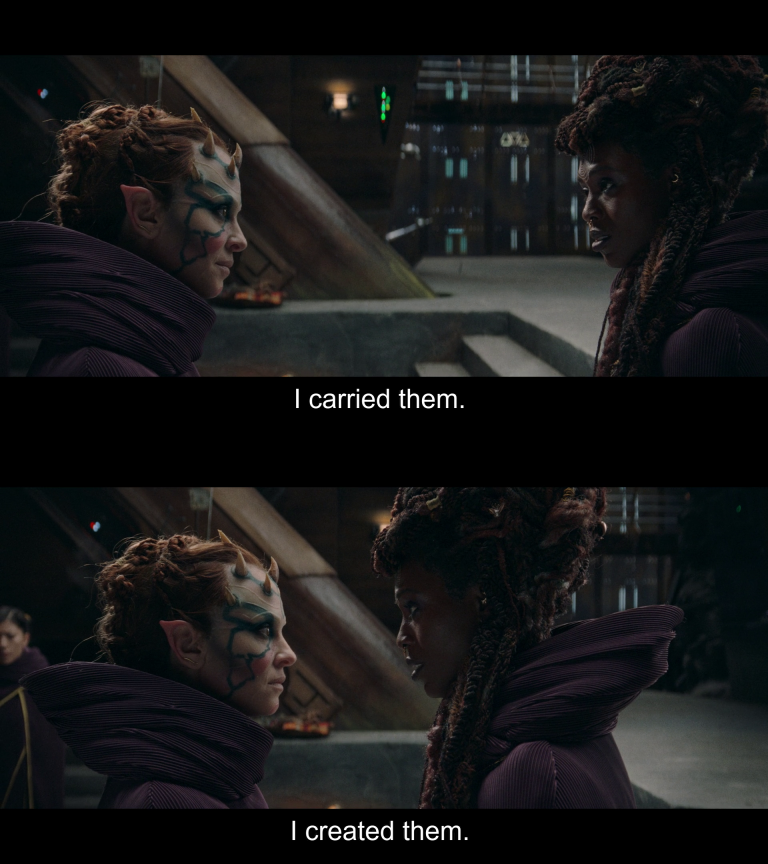Lesbian space witches are now an official, important part of Star Wars canon, thanks to The Acolyte

Lesbian couple Mother Koril (L) and Mother Aniseya (R) in The Acolyte (Lucasfilm/Disney)
Newly-released Star Wars series The Acolyte just made a major change to established Star Wars lore – by revealing that lesbian space witches created life from the Force before Darth Plagueis.
If none of that sentence made much sense to you, you’ve clearly not read the entirety of the incredibly detailed and comprehensive Star Wars wiki site Wookiepedia. But we have, so we’ll try to sum it up.
It’s also worth noting at this point that this article contains major spoilers for The Acolyte episode three.
Darth Plagueis was a legendary Dark Lord of the Sith who makes Darth Vader look like a massive wuss, frankly. He was extremely powerful and obsessed with immortality.
As pointed out by BoundingIntoComics, in the 2005 prequel movie Revenge of the Sith, Emperor Palpatine talks about how his former master “could use the Force to influence the midi-chlorians to create life. He had such a knowledge of the dark side, he could even keep the ones he cared about from dying.”
TL;DR: the power to create life using Force manipulation has always been considered a near-impossible feat.
However, in The Acolyte episode three, which dropped on Disney+ on Tuesday (11 June), we find out that the first person to create life in that way wasn’t Darth Plagueis at all. It was actually the newly-introduced leader of a band of Force sensitive witches (the Force Witches of Brendok), called Mother Aniseya (Jodie Turner-Smith).
The Acolyte’s first two episodes closely followed a pair of twins called Mae and Osha (Amandla Stenberg). When we first tune in, Mae is on a murderous rampage against four Jedi: killing her first victim, Jedi Master Indara (Carrie-Anne Moss) in the first few minutes of episode one.
Osha (full name: Verosha) a former Jedi padawan who ended up working as a mechanic, ends up helping her former Jedi master, Sol (Lee Jung-jae) to try to get to the bottom of her sister’s crimes. The sisters come face to face at the end of episode two.
Aniseya explains that she used the Force to bring to life two embryos, carried by her fellow force sensitive witch Mother Koril (Margarita Levieva). Those embryos (you guessed it) grow up to be Mae and Osha.
Oh, and did we mention that Aniseya and Koril are a couple? They aren’t just space witches, they’re lesbian space witches. We love to see it, especially given the increasingly virulent right-wing arguments against surrogacy for same-sex couples.

Of course, we weren’t exactly surprised to see this queer representation pop up in The Acolyte: it was always going to be an LGBTQ+ extravaganza.
Transgender icons Abigail Thorn and Jen Richards are both involved with the series – Thorn plays a character called Ensign Eurus, and Richards is one of the writers. Plus, showrunner Leslye Headland is a lesbian, and her wife Rebecca Henderson also appears in The Acolyte alongside Thorn and many other LGBTQ+ icons.
Amandla Stenberg is gay and non-binary and uses she/her and they/them pronouns. Charlie Barnett – who plays yellow lightsaber-wielding Jedi Yord Fandar, is gay and says that he realised the truth about his sexuality when he was just 13.
Stenberg has brushed off complaints by some fans that the show is making Star Wars “woke”, saying: “There’s a vast array of Star Wars fans. There is a specific kind of Star Wars fan [who’s] very vocal on the internet They’ve called our show The Woke-alyte, which I’m like, ‘OK, what about it?’”
However, the ratings don’t side with the critics: The eight-part series has already broken records, despite the conservative tears and sabre-rattling about its inclusivity.
TVLine reported that the first episode garnered 11.1 million views across the first five days of streaming, making it the biggest launch of the year on the streaming service. The series beat Disney+ competitors including Doctor Who, Marvel’s Echo and X-Men ‘97.
How did this story make you feel?

